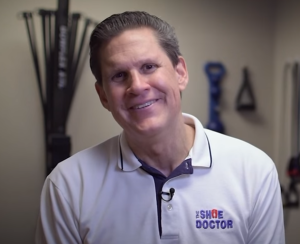Plantar fasciitis is a painful condition where the plantar fascia, a connective tissue on the bottom of your foot, becomes inflamed. Plantar Fasciitis can be caused by many different things including wearing shoes that don’t fit properly or standing for extended periods of time. Plantar Fasciitis typically causes pain in the heel and arch area of your foot which worsens when you stand up from sitting or after prolonged periods of weight-bearing activity. Plantar Fasciitis often occurs because these tissues become irritated due to overuse and tightness. In this post, we will discuss 10 common misconceptions about Plantar Fasciitis as well as some tips on how to prevent it from happening to you!
1. You Can’t Play Sports if You Have Plantar Fasciitis
In most cases, you should avoid high-impact exercises. However low impact workouts such as walking or cycling in special sport’s shoes for plantar fasciitis can be helpful because they help deal with the issue much easier and don’t overdo it by making your feet relax too quickly which would only make things worse than before.
2. Plantar Fasciitis is Hereditary
You probably know that there are quite a lot of health conditions that can be passed on from an individual to later generations with genes, for example, bunion formation. However plantar fasciitis doesn’t have any scientifically approved predispositions; it means you don’t need to worry about getting this disorder if your mom or dad has it too.
3. Plantar Fasciitis Occurs Only in Seniors
Plantar fasciitis is a condition that affects the fascia in your foot. It’s most common among older people, but younger people can get it too! Higher risk factors include having multiple chronic health conditions or being overweight because this increases pressure on our feet from all around as we walk–even if you’re just standing still for an extended period of time like at work every day.
Plantar fasciitis is also more common in people who are on their feet a lot, so if you have an active job or lifestyle–especially one that involves being on your feet for long periods of time each day–you might be at risk.
Plantar fasciitis can cause pain regardless of age, but it’s what is most commonly referred to as the “stiff” feeling you get when first getting out of bed in the morning. It happens because plantar fasciitis causes inflammation around our arch and heel which makes everything tighten up overnight while we’re lying down. As soon as you take steps after waking up without stretching them out first (which would make things feel better), the pain can be quite intense. Plantar fasciitis is also sometimes referred to as “heel spur syndrome.”
4. Heel Spurs are the Cause of Plantar Fasciitis
The most common misconception about plantar fasciitis is that it only affects the heel. In fact, around 10% of Americans are also diagnosed with a bony spur called a “heel spurs” which start growing from under your heels and can be difficult to find as an x-ray would reveal its presence. Plantar fasciitis has no relation to heel spurs whatsoever, but if you have plantar fasciitis and your pain is in your toes or even around the arch of your foot–it’s not because of a spur.
Plantar fasciitis and heel spurs are often connected, but there’s no direct connection between them. It’s also common for people who have one or both conditions not to experience any pain at all in their feet due to the presence of a spur on either side of your sole (heel). In cases like these- where someone has been diagnosed with both plantar fasciitis AND healing problems related to foot shock from excessive activity during weight-bearing phases such as running/jogging etc. Sometimes doctors will opt instead simply to perform minor surgery than large open-type operations since most studies have shown this kind of surgery to be successful.
5. Plantar Fasciitis Only Happens for People With ‘Flat Feet’
The statistics show that 50% of people with plantar fasciitis also suffer from fallen arches. This means there’s a high chance you could be experiencing this condition too.
The reason why your feet hit the ground when standing is that their arch collapsed, making all toes touch down suddenly without any warning signs or symptoms beforehand; luckily though it can easily get fixed through various treatments such as inserts for shoes that support weak areas in our body.
The plantar fascia band is a strong, flexible tissue that supports your feet. The more you stress it and the easier its position will become unnatural due to repetitive heel pain from running or other activities such as hiking up hillsides which can lead to runner’s knee/Achilles tendinitis in some cases! As mentioned before there’s no need for numbers because anyone who notices their heels hurting should go see an expert ASAP- don’t waste time worrying about what might happen if this goes untreated.
6. Plantar Fasciitis is Caused By Exercising Too Much
Plantar fasciitis is a very common cause of heel pain that affects many people, regardless of whether they are an athlete, fitness enthusiast, exercising too much or not. The factors leading up to this condition can be anything from poor foot mechanics and posture issues all the way down to overweight footwear due in part to your weight being obese.
The plantar fascia is a thick band of tissue that connects the toes with our ankles and this connective tissue will become inflamed from stress on it from certain activities such as running long distances or over-pronating feet when walking. Plantar fascial tightness may also play a part in plantar fasciitis but not always!
7. Plantar Fasciitis is Caused by Flat Feet
Flat feet are not the cause of plantar fasciitis, but it’s possible that they could make you more susceptible to developing this painful condition. If your arches slope overly steeply (and most people do), then running or other exercises where there is a lot of stress placed on these areas may lead towards heel spurs which can eventually form into something worse like chronic pain and even injury!
8. Bad Running Shoes Cause Plantar Fasciitis
Running shoes are not to blame for Plantar Fasciitis. This is a common misconception about Plantar Fasciitis in athletes. While it is important for runners and other athletic people to wear appropriate footwear, the problem of Plantar Fasciitis isn’t always caused by running with bad shoes, but more often than not due to overuse of the Plantar Fascia.
It is crucial to maintain good foot health and wear shoes that fit properly in order to help prevent Plantar Fasciitis from developing. Other measures you can take are icing your feet regularly if they are sore or strained, stretching before and after physical activity, and taking a break from strenuous activities every now and then.
9. You Can Recover By Stopping All Activity
Many people believe you can recover by stopping all activity, but plantar fasciitis is not an injury that should be taken lightly. Resting the foot can definitely help, but it’s actually better to continue with physical activity while dealing with plantar fasciitis because doing so has been shown to improve recovery rates. The idea of resting your feet with plantar fasciitis is a common misconception and can actually slow down your recovery time.
10. There’s No Cure Other Than Surgery for Plantar Fasciitis
The most common heel pain reason is to do with joggers’ heal. However, you cannot heal without proper screening at a hospital as the chances are high that your problem could be confused for another more serious issue or just an infection and therefore not treated properly.
The treatment is known already by many people who suffer from this type of injury but it’s important not only to visit your doctor regularly during the treatment time frame since they will always still come back again if left untreated once the complete healing process starts.
Medics understand that every patient may have unique symptoms, reasons, and the complexity of their problem. That’s why it’s so important to exclude other common heel pain causes like nerve irritation or arthritis in order for them to develop an effective approach towards healing your condition without wasting time on something minor. Answering “is there a cure? Yes! But different treatments will work depending on how severe your case is.”
Your Takeaway:
There are many reasons why people develop plantar fasciitis, but there’s no need to panic if you notice the symptoms. Your therapist will be able to guide treatment that’s right for YOUR body and needs with minimal pain! And don’t forget about taking steps every day – even just around your house or yard-to exercise those feet without abusing them too much.
We’ve debunked 10 common misconceptions about plantar fasciitis. To recap, you can:
- play sports if you have plantar fasciitis
- it’s not caused by hereditary or in seniors only
- heel spurs are not the cause of this condition
- and it doesn’t just happen to people with flat feet
- it is possible for someone who exercises too much to get plantar fasciitis but that isn’t always the case either – usually, your shoes will be more likely to be at fault than yourself
- for some sufferers, there may not be a cure other than surgery but many treatments exist which promote healing without invasive procedures being necessary
If you think you might have any kind of foot injury, call us today!
The Shoe Doctor Has Specialized In Providing Custom Orthotics For 20 Years.
People want to take care of their feet, they just don’t know how to do it right. The Shoe Doctor provides health feet education to teach people how to care for their feet. Most people wait to come to see us when they can’t stand the foot pain anymore or their feet need the equivalent of a root canal! It would be much easier and less expensive to do bi-year maintenance. In some ways, we should take better care of our feet than teeth, because you can replace every tooth in your mouth with implants, but there is no such thing as a foot transplant!
The right orthotic insoles can greatly reduce foot, knee and hip pain while increasing performance and comfort. Russell at The Shoe Doctorwill help educate and assist you in finding the perfect solution for your particular situation. We will create a 3D map of your feet and make custom orthotics for your hiking boots, everyday shoes, and everything else in between. These orthotics, along with our expert advice, will get you using orthotics like a pro, and have you performing at the peak of your abilities in no time! If you are in the San Francisco Bay Area, give The Shoe Doctor a call to get the best custom orthotics in the area! We are here to assist you, give us a call at (925) 820-0220 for your free consultation!


